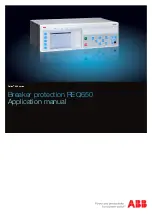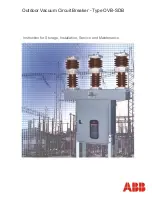
Technical data
DFS 4 EV
Series
DFS 4
Number of poles
2
4
Tripping characteristics
Type A DIN EN 61008-1
Rated current
25 A
40 A
Rated residual current I�n
30 mA
Max. switch-off times (AC)
1 × I�n: ≤ 0.3 s; 5 × I�n: ≤ 0.04 s
Operating voltage range
of test circuit
100 V ...250 V AC
185 V ...440 V AC
Active
additional
device
in sys. on
IEC 62752
DC tripping
current
max. 6 mA
Max. switch-off
times (DC)
6 mA ≤ 10 s; 60 mA ≤ 0.30 s; 300 mA ≤ 0.04 s
Operating
voltage
(DC detection)
single-phase 85 V ...265 V AC
Internal con
-
sumption
2 W
Rated surge voltage capacity
4 kV
Rated short-circuit current
10 kA
Max. rated switching capacity
500 A
Rated insulation voltage
400 V
Rated frequency
50 Hz
Current heat loss per current
path
0.4 W
1.3 W
Max. thermal back-up fuse
25 A
40 A
Max. short-circuit back-up
fuse
100 A
Back-up fuse type
gG
Max. number of conductors
2 per terminal (of same type and dia.)
Connector
cross-
section
solid
1 × 1.5 ...50 mm² (1-conductor connection),
2 × 1.5 ...16 mm² (2-conductor connection)
flexible
1 × 1.5 ...50 mm² (1-conductor connection),
2 × 1.5 ...16 mm² (2-conductor connection)
stranded
1 x 1.5 ...50 mm² (1-conductor connection),
2 x 1.5 ...16 mm² (2-conductor connection)
Tightening torque
2.5 Nm ...3 Nm
Installation position
optional
Max. operating altitude
2,000 m above sea level
Mech. endurance
min. 5,000 switching cycles
Electr. endurance
min. 2,000 switching cycles
Storage temperature
-25°C ...60°C
Ambient temperature
-25°C ...40 °C
Resistance to climatic
changes
conforming to DIN IEC 60068-2-30: damp/heat,
cyclic (25°C / 55°C; 93% / 97% rel. hum.)
Shock resistance
20 g/20 ms duration
Vibration resistance
>
5 g (f ≤ 80 Hz, duration
>
30 min.)
Mounting
Mounting rail in accordance with EN 60715
Housing type
distribution installation housing
Housing material
Thermoplast
Protection class
IP20 (front side: IP40)
Sealable
Yes
Dimensions
W 72 mm (4 TE) × H 85 mm × D 75 mm
Installation depth
69 mm
Design requirements
DIN EN 61008-1, DIN VDE V 0664-120,
E DIN IEC 62752, EN 61000-6-3
Effective value of tripping threshold
Pulsating
DC residual current:
Additional device
active: *
Additional device
not active:
0°
> 4.5 mA
> 10.5 mA
90 °
> 6.3 mA
> 7.5 mA
135 °
> 3.3 mA
> 3.3 mA
* Tripping values as per EN DIN IEC 62752
Warranty
All professionally installed, unaltered devices are covered by warranty during the
statutory guarantee period from the day of purchase by the end user. The warranty
is not applicable to damage incurred during transport or caused by short-circuit,
overloading or improper use. In the event of defects in workmanship or material,
which are discovered within the warranty period, the company will provide repair or
replacement free of charge. The warranty will be rendered null and void if the device
is opened without authorisation.
Wiring diagrams
6 N
5 N
~
V
two-pole
(N)1 3 5 7(N)
(N)2 4 6 8(N)
V
four-pole, neutral on left or right, depending on device version
Installation and Operating Manual
for two-/four-pole residual current circuit-breakers
in DFS 4 EV model ranges
Intended use and mounting
For snapping onto mounting rail and for installation in distribution boards with cor
-
responding device covers. Prevents contact with dangerous active parts.
EV-specification residual current circuit-breakers are type-A devices with integrated
additional devices that isolate the switching contacts of the RCCB when smooth DC
residual currents > 6 mA are detected. They are only suitable as protective devices for
the power supply of electric vehicles as per HD 60364-7-722 in charge operating mode
3 according to EN 61851-1.
Electrical connection
Guide all active conductors (outer cables L1, L2, L3 and the neutral conductor MP/N)
through the switch. The input terminals are 1, 3, 5, 7; the consumer system side is 2,
4, 6, 8. For two-pole applications, two-pole residual current circuit-breakers must
be used. Scrape and grease aluminium conductors immediately before connection.
Integrated additional device
The integrated additional device, which depends on the auxiliary voltage, detects
smooth DC residual currents. If these currents exceed 6 mA, the additional device
isolates the switching contacts of the residual current circuit-breaker. The LED in-
dicates that the additional device is active. The additional device is supplied via an
adaptor circuit integrated at terminals 1 and 7. An alternating voltage > 85 V must be
present at these terminals for the additional device to function properly. If the LED
does not illuminate, then only tripping via type A residual currents is still guaranteed.
Testing and functional check
An insulation test of the user equipment is to be carried out in accordance with DIN
EN 61557-2. This may only be done when the device is switched off. Insulation test-
ing when the device is switched on or insulation testing on the input side may lead
to incorrect measured values. A functional inspection of the residual current circuit-
breaker itself is possible with connected mains voltage by pressing the test button T
and, as in commercial use (BGV A3), should be carried out at least every six months in
the case of stationary systems and should be repeated every working day in the case
of non-stationary systems.
Application instructions and warnings
The following notes and warnings must be observed in order to ensure safe opera
-
tion:
1.
Installation may only be carried out by an electrician who is familiar with the rel
-
evant national installation regulations.
2. Without any additional protective housing, residual current circuit-breakers
should only be stored and operated in a dry, low-dust environment. An aggressive
atmosphere must also be avoided.
3.
The user must be made aware of repeat testing using the test button T.
4. Please be aware that the short-circuit back-up fuse (SCPD) does not ensure any
thermal overload protection. Thermal overloading must be ruled out as a matter
of priority by means of thorough project planning or using the specified thermal
back-up fuse (OCPD).
5.
Trips due to leakage currents caused by surge voltage cannot be completely ruled
out. In cases where an interruption of the power supply may lead to potential
dangers for humans and animals or serious damage to property, residual current
protection should be implemented by means of increased surge current strength,
selective residual current circuit-breakers and upstream surge arresters. In spe-
cific cases, the switching status should be monitored by means of an auxiliary con-
tactor at the residual current circuit-breaker and an appropriate signalling device.
Important information on tripping with pulsating DC residual currents (type A)
Pulsating DC residual currents also contain a constant part (DC) in addition to
spectral parts of the mains frequency and their fluctuations. The integrated
additional device, depending on its physical setup, cannot differentiate be-
tween a pure smooth DC residual current and the constant (DC), spectral part
of a pulsating DC residual current and thus evaluates these in the same way.
If the additional device is active, pulsating DC residual currents will therefore
cause a premature trip (see table part "Effective value of tripping threshold").
The switch-off times stipulated in relevant product standards and installation regula-
tions remain unaffected by the integrated additional device.
Doepke
3930255
|
06/2014
|
Doepke Schaltgeräte GmbH, Stellmacherstraße 11, D-26506 Norden
DE EN




















